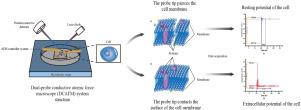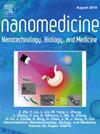Measurement of cell electrical signal by dual-probe atomic force microscopy
IF 4.6
2区 医学
Q2 MEDICINE, RESEARCH & EXPERIMENTAL
Nanomedicine : nanotechnology, biology, and medicine
Pub Date : 2025-06-30
DOI:10.1016/j.nano.2025.102838
引用次数: 0
Abstract
The conduction of electrical signal plays critical roles in neuron activities. The capacity of atomic force microscopy to establish physical contacts at the nanoscale and offer higher spatial resolution compared to conventional electrical recording methods, such as patch clamp, significantly enhances our understanding and analysis capabilities. This capability enables the direct visualization and precise quantification of the electrical properties within specific cellular membrane regions. In this study, we use conductive probes in our self-developed dual-probe atomic force microscope system as nanoelectrodes to measure the electrical signals of SH-SY5Y cell. Given that SH-SY5Y cells exhibit neuron-like properties and are relevant to human neurological diseases, researching these cells provides valuable insights into neuronal behavior and pathology. In dual-probe atomic force microscope, one probe is responsible for sending stimulation signals to the cells, while the other probe receives transmitted information from the cell. By modulating the pressure applied by the tip to the cell membrane, the effects on SH-SY5Y cells at different contact depths and time intervals were investigated, along with the monitoring of cellular potential changes. The changes in cell potential were detected. Two different nonlinear electrical characteristics were observed, which indicate the cell membrane exhibits adaptability and self-repair ability, achieved by regulating the state of ion channels to ensure membrane potential stability. These results provide a new way to stimulate and study the electrical characteristics and physiological behaviors of cells and other biological samples, potentially revealing new insights of neuron activities.

用双探针原子力显微镜测量细胞电信号。
电信号的传导在神经元活动中起着至关重要的作用。原子力显微镜在纳米尺度上建立物理接触的能力,与传统的电记录方法(如膜片钳)相比,它提供了更高的空间分辨率,大大提高了我们的理解和分析能力。这种能力可以直接可视化和精确量化特定细胞膜区域内的电学性质。本研究采用自行研制的双探针原子力显微镜系统中的导电探针作为纳米电极,对SH-SY5Y细胞的电信号进行了测量。鉴于SH-SY5Y细胞表现出神经元样特性并与人类神经系统疾病相关,研究这些细胞为神经元行为和病理提供了有价值的见解。在双探针原子力显微镜中,一个探针负责向细胞发送刺激信号,另一个探针负责接收细胞传递的信息。通过调节尖端对细胞膜施加的压力,研究了不同接触深度和时间间隔对SH-SY5Y细胞的影响,并监测了细胞电位的变化。检测细胞电位的变化。观察到两种不同的非线性电特性,表明细胞膜具有适应性和自我修复能力,这是通过调节离子通道状态来保证膜电位稳定来实现的。这些结果为刺激和研究细胞和其他生物样品的电特性和生理行为提供了新的途径,可能揭示神经元活动的新见解。
本文章由计算机程序翻译,如有差异,请以英文原文为准。
求助全文
约1分钟内获得全文
求助全文
来源期刊
CiteScore
11.10
自引率
0.00%
发文量
133
审稿时长
42 days
期刊介绍:
The mission of Nanomedicine: Nanotechnology, Biology, and Medicine (Nanomedicine: NBM) is to promote the emerging interdisciplinary field of nanomedicine.
Nanomedicine: NBM is an international, peer-reviewed journal presenting novel, significant, and interdisciplinary theoretical and experimental results related to nanoscience and nanotechnology in the life and health sciences. Content includes basic, translational, and clinical research addressing diagnosis, treatment, monitoring, prediction, and prevention of diseases.

 求助内容:
求助内容: 应助结果提醒方式:
应助结果提醒方式:


